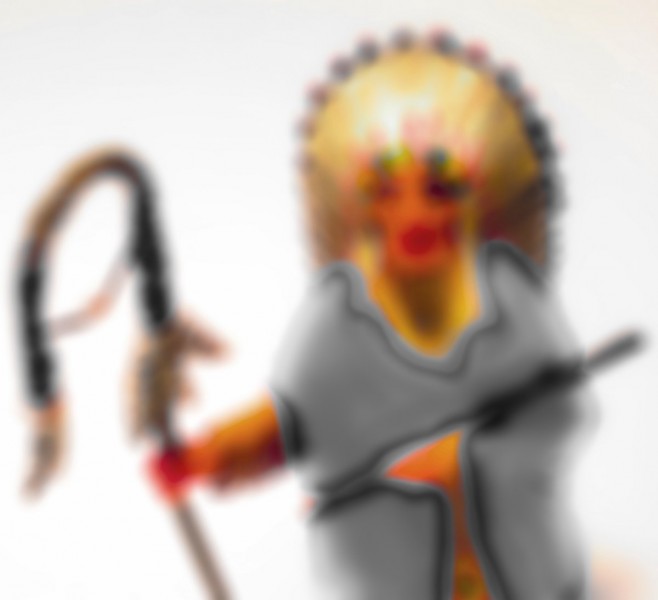We can say many interesting things about children. But their eyes are something special.
The beginnings of sight are magic by itself. These small globes that make it possible to see are the most expressive part of the face. Some even say that you can see the soul through the eyes. And you cannot just look into the eyes of the little ones, but they can look into yours.
On this page:
What is the starting line?
Despite being out of the womb with eyes already two thirds formed,1)”Your Infant’s Vision Development” by Gary Heiting, O.D., babies are practically born blind by legal standards. They have a visual acuity of about 20/800, 2)”How brains learn to see” – Pawan Sinha’s lecture at TEDIndia in November 2009; in other words, their vision is 40 times worse than what it will be in a few months. They did not have much to see in the womb.
Their perception of light is almost equally poor. Because newborn eyes are not very sensitive to light, they can sleep with no problem in a lighted room. 3)”Your Infant’s Vision Development” by Gary Heiting, O.D..
And they can even sleep with their eyes open! (As some of us at school or work might like to do.) Here’s an example:
How newborn eyes develop
Once the eyes receive stimuli, they have every reason to begin to see; even the most trivial thing that appears in a newborn’s visual field is new and interesting. A newborn’s eyes are rapidly developing and in the first month can reach an acuity of 20/120.4)”What can my baby see?” by Russell D. Hamer, Ph.D., revised by Giuseppe Mirabella, Ph.D., article originally published in Parents’ Press, in November 1990.
At 3 months, a baby’s eyes are fully developed, and at 4 months, their sight is twice as good. And then the magic of vision really begins!
Have you ever thought about how you actually see? Without going too much into detail, everything we see reflects light. Without light, sight cannot function.

Eye muscles give the eye a particular form required to focus. In other words, it chooses from a distance a plane for which the image is clearer. You can’t clearly see near and far at the same time. (Have you tried?)
Newborns have not yet learned to control these muscles. Until two months, due to lack of coordination, their eyes often sit at strange positions, which do not allow them to focus clearly; but do make them seem adorable. (Have you ever noticed how you feel like laughing when you see someone – a comedian, for example – crosses their eyes? It’s funny, but no one knows why!)
Once light reaches the retina, three types of photoreceptors encode it into electrical signals. Each type corresponds to a basic color. You see only three colors! But like a TV screen or a computer monitor, the intensities of these colors and the way they combine lead to a broad color palette.
The retina in each eye has 100 million light-sensitive cells 5)”What can my baby see?” by Russell D. Hamer, Ph.D., revised by Giuseppe Mirabella, Ph.D., article originally published in Parents’ Press, in November 1990. But babies don’t have a well-developed retina, so they initially don’t see in color. In the first few months of life, they see in grayscale. The colors red, orange, yellow, and green are the first to bring chromatics into the picture. It takes longer for colors like blue and violet (with smaller wavelength) to appear because there are fewer photoreceptors dedicated to their perception 6)”An evaluation of color preference in early infancy” – study by Russell J. Adams, published in Infant Behavior and Development nr. 2/19877)”The influence of stimulus size on newborns’ discrimination of chromatic from achromatic stimuli” – study by Russell J. Adams, Daphne Maurer and Heidi A. Cashin, published in Vision Research nr. 12/1990.


An electrically encoded image is transmitted to the brain via the optic nerve – a bundle of about one million nerve fibers that converge on the surface of the retina. And the brain must understand these electrical impulses in order to project to our conscious minds an image of reality. Because what we see is nothing but a mentally constructed image, the brain must learn how to do this. In a way, it’s like learning how to string words into coherent sentences.
If you find that bewilderingly complex, imagine how it must be for babies!
The mother and everything that moves

Even after their eyesight has undergone an appreciable period of rapid development, babies do not focus well. They only perceive well-defined shapes and distinct colors. Some experts therefore recommend that new mothers frame their faces with a particular hairstyle. Even though a baby’s ability to see is extremely poor, in just a few days he distinguishes his mother’s face and he is more attracted to it than to any other 8)”Mother’s face recognition in newborn infants: learning and memory” by I.W.R. Bushnell, article published on April 19, 20019)”Mother-stranger face discrimination by the newborn” – study by Tiffany M. Field, Debra Cohen, Robert Garcia, Reena Greenberg, published in Infant Behavior and Development, number 1/1984. Mommy is the most beautiful! Thus, in a wonderful way, love is blind even at birth.
Motion is the key used by the brain to open the gates of understanding to the images sent from the eye. 10)”How brains learn to see” – lecture by Pawan Sinha at TEDIndia in November 2009. Those with poorly developed vision, such newborns and people with congenital diseases who recover their sight after an operation, have difficulty distinguishing objects in a still image. But when things start to move, this problem disappears. No wonder babies like crib mobile and people who make funny faces in front of them!
Movement not only makes it easier to understand which things are unitary, but it also helps when judging distance. When an object approaches, it gets bigger, and when it moves away, it gets smaller. For babies, the mere fact that something that draws their attention (parents’ faces above all) changes distance from their eyes is a great experience! As a parent, if you put yourself in your child’s place, you can help him discover the world. And you can share with him his astonishment for things apparently small.
A newborn’s blue eyes

Who would like to have blue eyes?! They have a reputation for being charming, especially in regions where they’re rare. (On the contrary, having blue eyes is no big deal in Estonia; you’ll see those blue flashes wherever you turn your head.)
Almost all Caucasians are born with blue eyes, white skin, and light hair that will darken as they grow up.
Although newborn blue is evident only in the first few days after birth, eyes remain more or less blue until about 6 to 9 months, when they usually begin changing color. This process takes up to 2 to 3 years, at which point the eyes will have taken on a completely different color (usually for life, but changes in color may occur even later).
Just as the color blue has different shades, so do blue eyes as well. They can range from light blue, like the sky, to grayish blue, like the sea. Non-Caucasian babies may be born with blue eyes, but this happens much more rarely; they usually come into the world with eyes so dark that no change is observed.
How eyes change color
What causes eye color to change? It is melanin, a brownish pigment that gives skin, hair, and irises (the colored part of the eye) color. Melanin protects against ultraviolet radiation (mostly, but not only, from the Sun). In fact, melanin is first produced in the body when the baby is first exposed to light, which includes UV radiation. The more melanin the body produces, the more pigment irises accumulate, thus darkening the eyes.
In fact, blue eyes just seem blue; there is no pigment in the iris to give them this color. The color of blue eyes is just a result of the phenomenon of light-scattering, the same phenomenon that gives the sky its blue color 11)”Blue Eyes” by Clyde W. Mason, published in Journal of Physical Chemistry in 192412)”Biochromy: Natural Coloration of Living Things” by Denis Llewellyn Fox, book published University of California Press in 1979.
Another interesting fact is that no eye has a uniform color. Unique patterns are generated for each individual. (Yeah, baby, no one has eyes like yours.)

Colors from ancestors
Genetics plays a very important role in how eye color changes. Parents’ and grandparents’ eye colors may give an idea of what a child’s eye color will be, but because the mechanism of eye color change is complex, surprises can still happen 13)”Eye color: The myth” – article written by Dr. John H. McDonald on December 8, 2011. Many genes (not just one) determine this feature 14)”The eyes have it on multiple gene question” – article with explanations by Dr. Rick Sturm, published on February 20, 2007. There are clearly two genes involved, but various studies have concluded that up to 16 genes have an influence 15)”Genotype–phenotype associations and human eye color” by Désirée White and Montserrat Rabago-Smith, article published in Journal of Human Genetics in January 2011.
If a child’s eyes remain blue, this is due to a mutation that happened 6,000 to 10,000 years ago, according to a study conducted at the University of Copenhagen by a team led by Hans Eiberg. Moreover, all blue-eyed people have a common ancestor: the individual who had the first blue eyes 16)”Blue eye color in humans may be caused by a perfectly associated founder mutation in a regulatory element located within the HERC2 gene inhibiting OCA2 expression” – study by Hans Eiberg, Jesper Troelsen, Mette Nielsen, Annemette Mikkelsen, Jonas Mengel-From, Klaus W. Kjaer and Lars Hansen, published on January 3, 200817)”Blue eyes result of ancient genetic ‘mutation’” – article written by Roger Highfield, published in The Telegraph on January 30, 200818)”More than meets the blue eye: You may all be related” – article written by Elizabeth Weise, published in USA Today on February 5, 2008. It really is a big family, with hundreds of millions of members!
So if you have a baby and you like blue eyes, stare into them and get an eyeful while you can before they change color. Smiling.
In fact, there is a much better reason to do this: he will fall deeply in love with you. And you as well, if you haven’t done so already.
The most amazing facts about newborn's anatomy - incredibly different from what they will become
References
| ↑1, ↑3 | ”Your Infant’s Vision Development” by Gary Heiting, O.D. |
|---|---|
| ↑2 | ”How brains learn to see” – Pawan Sinha’s lecture at TEDIndia in November 2009 |
| ↑4, ↑5 | ”What can my baby see?” by Russell D. Hamer, Ph.D., revised by Giuseppe Mirabella, Ph.D., article originally published in Parents’ Press, in November 1990 |
| ↑6 | ”An evaluation of color preference in early infancy” – study by Russell J. Adams, published in Infant Behavior and Development nr. 2/1987 |
| ↑7 | ”The influence of stimulus size on newborns’ discrimination of chromatic from achromatic stimuli” – study by Russell J. Adams, Daphne Maurer and Heidi A. Cashin, published in Vision Research nr. 12/1990 |
| ↑8 | ”Mother’s face recognition in newborn infants: learning and memory” by I.W.R. Bushnell, article published on April 19, 2001 |
| ↑9 | ”Mother-stranger face discrimination by the newborn” – study by Tiffany M. Field, Debra Cohen, Robert Garcia, Reena Greenberg, published in Infant Behavior and Development, number 1/1984 |
| ↑10 | ”How brains learn to see” – lecture by Pawan Sinha at TEDIndia in November 2009 |
| ↑11 | ”Blue Eyes” by Clyde W. Mason, published in Journal of Physical Chemistry in 1924 |
| ↑12 | ”Biochromy: Natural Coloration of Living Things” by Denis Llewellyn Fox, book published University of California Press in 1979 |
| ↑13 | ”Eye color: The myth” – article written by Dr. John H. McDonald on December 8, 2011 |
| ↑14 | ”The eyes have it on multiple gene question” – article with explanations by Dr. Rick Sturm, published on February 20, 2007 |
| ↑15 | ”Genotype–phenotype associations and human eye color” by Désirée White and Montserrat Rabago-Smith, article published in Journal of Human Genetics in January 2011 |
| ↑16 | ”Blue eye color in humans may be caused by a perfectly associated founder mutation in a regulatory element located within the HERC2 gene inhibiting OCA2 expression” – study by Hans Eiberg, Jesper Troelsen, Mette Nielsen, Annemette Mikkelsen, Jonas Mengel-From, Klaus W. Kjaer and Lars Hansen, published on January 3, 2008 |
| ↑17 | ”Blue eyes result of ancient genetic ‘mutation’” – article written by Roger Highfield, published in The Telegraph on January 30, 2008 |
| ↑18 | ”More than meets the blue eye: You may all be related” – article written by Elizabeth Weise, published in USA Today on February 5, 2008 |
Did you like it? Now it’s your turn. You’ll make us very happy if you share this article with your friends:
And don’t forget to let us know what you think – we are really interested in your thoughts on this!



